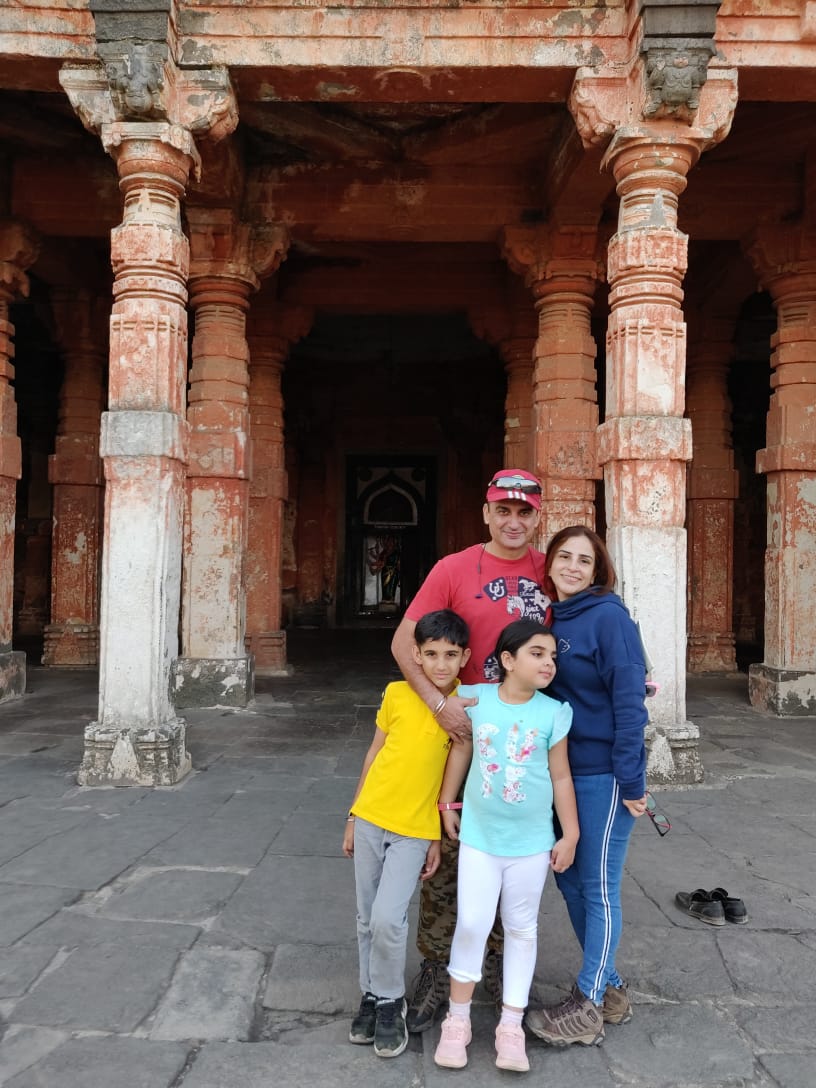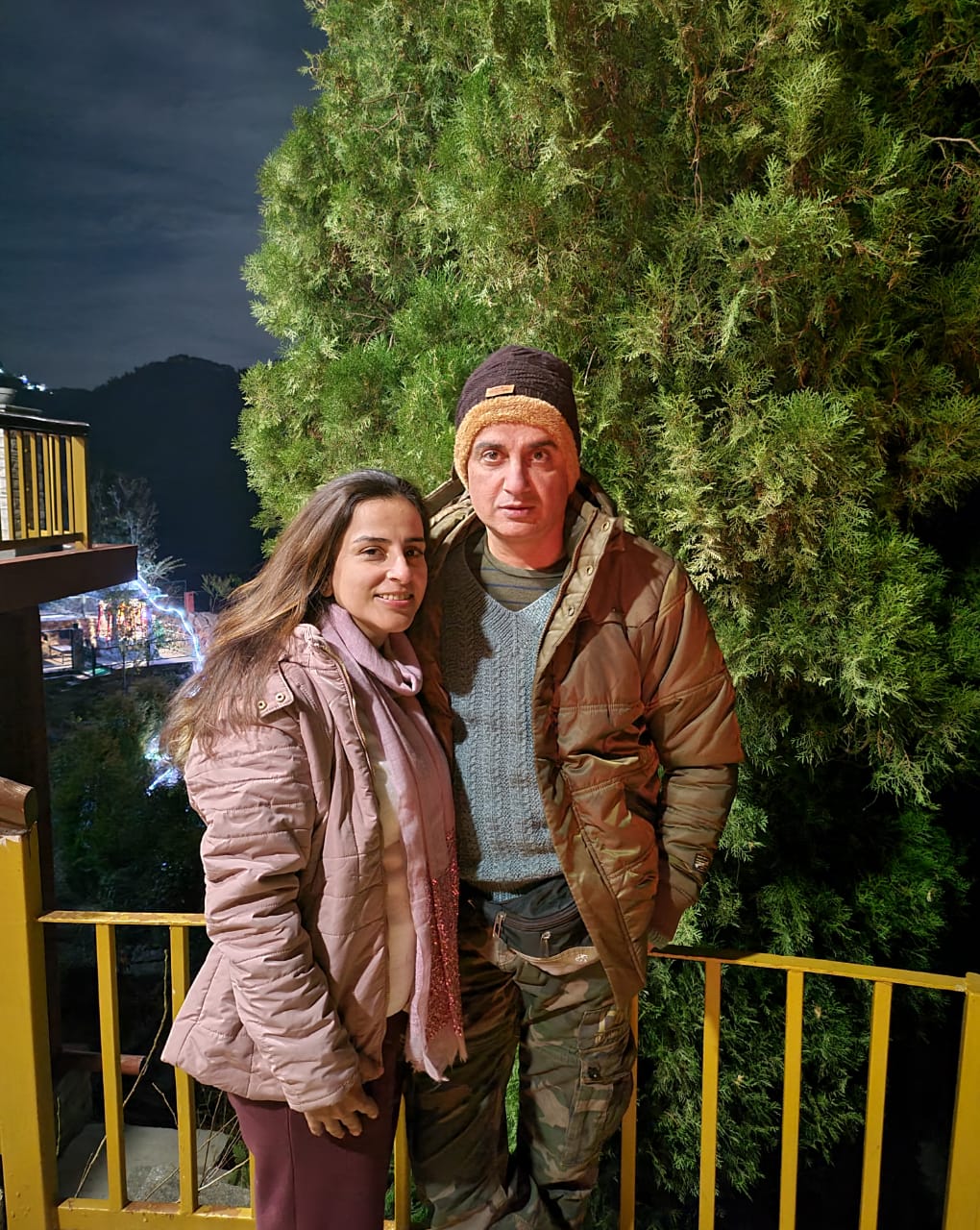The Deogiri fort (now known as Daulatabad) and Ellora are the top reasons to visit Aurangabad. Nothing beats the sheer majestic presence of these two heritage sites. Ellora is of course a UNESCO World Heritage Site. You can lose yourself for days on end discovering the beauty of these sites.
For 2018, we planned an itinerary spanning Maharashtra, MP and Gujarat. Winters are the best time to be driving across these states, since the summers can be punishingly hot, so I figured our annual road trip is as good a time as any to explore this part of the country.
Mumbai to Aurangabad by road
We headed out on 21 December, on a chill winter morning with Aurangabad being our first port of call. We drove towards Thane, which is to the North East of Mumbai and then onto NH 160 which goes through Nasik towards Aurangabad. The roads were once again very good and having left at 0600Hrs, by 0830Hrs we'd reached the outskirts of Nasik.
There's a new (relatively I guess, since it's now nearly 5 years old) flyover that goes over the heart of Nasik city. We zipped through this road which gave us a brilliant birds - eye view of the quaint town sprawled below us. Nasik looked really pretty in the early morning light, with sparse traffic. What vehicles were there didn't look in a tearing hurry to get anywhere either! The upside of this flyover was that in a matter of less than 15 minutes we'd crossed the town. The downside was that there was absolutely no restaurant or dhaba that we came across for the next 30 minutes. We were on the road since 0600HRS and everyone was rearing for a bit of breakfast!
In 45 minutes of crossing Nasik we got to Niphad. This is about 40 Kms away and home to the boutique Riveilo vineyard and winery. Thankfully, a Hotel Rudray was open for business. After a meal of passable idlis, dosas and milky tea we were back on our way to Aurangabad. A rather uneventful drive of about 3 more hours along the Aurangabad - Nasik highway got us to our destination, The Meadows Resort and Spa at Aurangabad. A word of caution though. After Niphad the road was in a sorry state, bad enough to question your reasons for visiting Aurangabad!
The Meadows is a sprawling resort on the road that leads to Deogiri (Daulatabad) fort. The first thing that hits you is the lawns and grounds. Unkempt and untended. There is a feeling of wistfulness that this evokes, harking to a bygone era of glory. The sorry state of disrepair and neglect evident all around you make this even more piquant. We'd booked a family cottage.
The room was huge, very well - furnished with an open lawn, comfortable beds and bathrooms with every creature comfort. The only issue was that most of the things had seen better days, and weren't functional! The faucets weren't sure which way to turn for hot water to run through. The couch sagged at one corner. They'd disconnected the television and the Window frames were jammed. To add, everything seemed a little dirty for some reason. Nevertheless, we used the facilities, dressed and decided to visit the Devgiri fort, which is around 10Kms from the resort.
En route, a couple of kms before the fort we stopped at a quaint dhaba for a sumptuous meal of mutton curry with naan, prepared and served by an extremely cultured gentleman, who spoke impeccable urdu! We sat on traditional 'khaats' placed before wooden trestle tables. They served us in dented steel plates and bowls. Dented they may have been, but everything was spotlessly clean and hygienic.
The chef had cooked the mutton in a slightly oily, though delicious brown gravy of onions and tomatoes. There was a hint of garlic and ginger seasoning. The piping hot Naans simply soaked it all up! If you are a foodie, the fare here should top you list of reasons to visit Aurangabad. After a most satisfying meal, we headed to the Daulatabad fort, getting there around 1600Hrs.
Deogiri / Daulatabad Fort
Apart from the usual gaggle of poorly constructed shops with their accompanying garbage outside the fort, the monument itself was reasonable clean and well maintained. We took one of the government licensed guides (highly recommended) to walk us through the monument and it's history.
Devgiri or Daulatabad fort as it is now know is supposedly around 1200 years old. Depending on who you ask, either the Rashtrakutas or the Yadava dynasty built it. Irrespective, it's original name is Deogiri / Devgiri fort. It changed hands down to Alaudin Khilji and then Muhammad Bin Tughlaq (remember the 'mad' king who shifted his capital from Delhi to Daulatabad and then back to Delhi? Yup, same bloke) who renamed it as Daulatabad.
The colonial / Nehruvian history aside, legend has it that this was the abode of Shiva. The fort gets its original name from the the surrounding hills, named Devgiri. Today, this stands as a massive, beautiful structure, a mute witness to a bygone era. If you are a history buff, this should be reason enough to visit Aurangabad.

The fort's entrance is well - organised. As we walked in with Joshi - guide, we saw masons at work in different places. According to MR. Joshi, in the last 3 years the ASI has carried out more repairs and restorations to the fort, than they've done in the last 50 years! Politics aside, it was really nice to hear that finally there is a government that cares about restoring our heritage and monuments that go beyond the Mughal era.

The Deogiri fort is built atop a hill. This is similar to most forts of it's era. It's 2 adjacent hills actually. The layout is such that any attacking army would need to circle upon itself at least a couple of times as they entered the fortress. Right from the first gate itself, there is no single path that goes straight for more than 50 meters before turning acutely and ending in a door. This effectively meant that war elephants couldn't be used as battering rams. This was because they simply wouldn't be able to generate the momentum required to break down the doors! Likewise, each time there is an incline, steps have been cut into the ground.
And there are several, the fort being on a hill. This necessitated that cavalry and elephants would have to slow down while ascending, since neither of these animals are great at climbing steps. Effectively this negated the possibility of an outright charge.
There are other cute things too that the builders have done. For instance, at one point you turn only to walk into a wall! To the left is a massive door, apparently leading into the fort. To the right is a smaller door, apparently of no significance. Naturally, given the grandeur of the left door, and the fact that the fort also seems to be on the left, attackers would want to break down that first.
Except, the left door leads to a dead end from where the defenders can get their jollies dropping boiling oil, javelins, arrows and other little nicknacks on the attackers for their collective entertainment. You've got to admit this was the pre - internet era and free entertainment was understandably hard to come by.
Once you make it past the 5 to 6 gates (I forget how many exactly), you get to the main complex. Like most Indian forts, this is a small town in itself. There are separate ponds for everyone. The horses, the commoners, women of the harems, higher officials, the queens and of course the kings each had their own watering hole. Each of these, besides a main reservoir, are fed by a siphon system that brings in water from a nearby river. This system was osentsibly built by Tughlaq and is truly a marvel of sustainable development!
Hang on though - neither Tughlaq nor any of his predecessors had any knowledge of irrigation systems. On the other hand, Vedic literature is pretty detailed on the technique of constructing canals and irrigation systems. To my mind, this is another clear case of ill - informed or prejudiced 'historians' attributing an an ancient Hindu accomplishment to an uneducated Islamic usurper! Remember the Qutub Minar, a Rajput observatory tower attributed to Qutbuddin Aibak? That's just one amongst several cases in point.
All along the pathway into the fort, there are small things done to prevent the onslaught of an attacking army. In the unlikely event of an attacking army making it this far, at the end of the fort there is a bridge connecting to the adjoining hill. About 30 meters across, this covers a sheer drop which forms a natural moat. On the other side is the final defense of the incumbents - a small castle right atop the peak. Getting to this castle necessitates the attacker should pass 3 'kaalkothris.'
Each of these is huge, pitch dark, with many ingenious defences. Venomous snakes and attacking bats (whatever the hell that must've been) were some of the deterrents. In addition there were 'invisible' holes in the ground that plummet thousands of meters down and 'invisible' holes in the roof that provide an unending supply of oil to ensure you slip through the holes in the ground. In other words, you'd think it would've been a better idea to return after enjoying the hot oil poured down from the initial gates.

Coming back to the main fort, the friendly neighbourhood Mughal, Aurangzeb built something called the 'Chini Mahal'. I couldn't quite see what was so great about it, but I guess it must've been formidable in it's heydays.
Sambhaji Maharaj and Devgiri Fort
The infamy of this joint is that Aurangzeb had kept Sambhaji Maharaj, the Maratha ruler, in captivity here. Apparently, Aurangzeb offered him a deal - convert to Islam, marry his daughter and become a vassal of the Mughals.
The alternative is what Sambhaji chose. Aurangzeb had his eyes burnt out and every inch of skin flayed from his body. The torture was spread over several days or weeks, depending on who you ask. Either ways, it led to an excruciatingly painful and torturous death eventually by beheading. Sadly, though this sounds as one of the top reasons to visit Aurangabad, there is not a single monument to Sambhaji here.
Nevertheless, we have a prominent road in our capital named after Aurangzeb, with nothing named after Sambhaji. Weird, or maybe I'm missing something here! What's worse is that our history books gloss over this glaring factoid amongst other 'silly little' misdemeanours of Aurangzeb. Pathetic, to say the least.
To my mind, the high point of the fort is the installation of the idol of Bharat Mata (Mother India)! Tughlaq desecrated the main temple of the fort and converted it to a mosque. Nothing new here though (as with most temples across the country). Apparently, when the Indian forces under Sardar Patel won against the Nizam of Hyderabad, they 'reclaimed' this temple. The first thing they did was to install an idol of Bharat Mata. This is the first idol of Bharat Mata where she isn't shackled by any chains. This was done to indicate the freedom of the country! Of course there are morons who have quite a different take on what Bharat Mata signifies! Looking for top reasons to visit Aurangabad - here is one more!

On our way back I called the Mumbai office of the Meadows resort and whined to them about the state the property was in. They were kind enough to agree to a full refund on the advance we'd paid. We left and checked in at the Keys Hotel in Aurangabad. What with every other hotel being sold out, this was the only choice left. Apparently there was some convention taking place around the same time in Aurangabad, . The Keys is a very efficient business hotel. Good rooms and restaurant and really nothing to particularly complain about. Next morning, post breakfast we left to check out Ajanta and Ellora caves.
Ajanta and Ellora Caves
Each time I see the Ellora caves, I can't get over the sheer scale of construction of the Kailasa temple! It is one of the most stupendous examples of human endeavour one can come across anywhere in the world. The chariot - shaped temple, carved out of one massive mountain painstakingly over God alone knows how many hundreds of years, is a feat that rivals the pyramids! They're the top reasons for tourists the world over to visit Aurangabad.
You could of course go by what historians say, that the Rashtrakutas made it somewhere in 700AD. Personally, I think the Rashtrakutas 'discovered' and possibly embellished the temple around that period. 700AD is a date being bandied as part of the 'cultural domination' policy followed by Imperial Britain and the Nehru - Azad - Romila coterie. While there are examples galore of this perfidy across the country, it is one of several reasons to visit Aurangabad.

Let's take a look at the historical evidence. The Rashtrakutas have built no other structure that even comes close to the engineering marvel and architectural genius that is the Kailasa temple. Sure, they were a powerful dynasty and deserve their place in history. But credit them with building the Kailasa temple in some 20 years? I don't think so! Consider this: The subterranean caves of the Kailasa temple are now sealed. Legend has it that this cave was apparently made by Lord Shiva. It's purpose: Serve as sanctuary for several thousand humans, animals, birds, insects, micro - organisms and fish during the great flood (remember Noah's ark?).

Another factor is that the only way the temple could've been built was by carving downwards from the peak of the mountain. Aerial photography suggests the symmetry of carving is perfect to the .0001 percentile margin of error. Builders would be hard - pressed to achieve this feat even today. Let alone in 700AD. And that, achieved while carving downwards, without the use of aerial photography / cartography. One can well imagine how they would've managed this feat without the use of any such tool!
Bottomline: Despite the establishment's attempts at force - fitting it into their convenient narrative, the origins of the cave and Kailasa temple are shrouded in mystery.
We spent a blissful 2 hours simply gazing at the exquisite carvings at the temple. Our next port of call were the Buddhist and Jain caves. It would take days and days of effusive language to even come close to describing the detailing that has gone into the carving of these temples. Suffice to say, they merit a visit over at least 3 to 4 days, to truly do them justice! Bottomline, if the Deogiri fort wasn't enough, then the Ajanta and Ellora complex are sufficient reason to visit Aurangabad!
After 2 hectic days of revisiting Indian history, heritage and culture, we were a tired but happy lot. We wound up with a quiet celebratory drink back at the hotel, all set for the next phase of our adventure, come morning!





Leave a comment
This site is protected by hCaptcha and the hCaptcha Privacy Policy and Terms of Service apply.